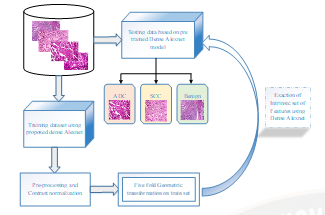Lung Disease Classification using Dense Alex Net Framework with Contrast Normalisation and Five-Fold Geometric Transformation
Main Article Content
Abstract
lung disease is one of the leading causes of death worldwide. Most cases of lung diseases are found when the disease is in an advanced stage. Therefore, the development of systems and methods that begin to diagnose quickly and prematurely plays a vital role in today's world. Currently, in detecting differences in lung cancer, an accurate diagnosis of cancer types is needed. However, improving the accuracy and reducing training time of the diagnosis remains a challenge. In this study, we have developed an automated classification scheme for lung cancer presented in histopathological images using a dense Alex Net framework. The proposed methodology carries out several phases includes pre-processing, contrast normalization, data augmentation and classification. Initially, the pre-processing step is accompanied to diminish the noisy contents present in the image. Contrast normalization has been explored to maintain the same illumination factor among histopathological lung images next to pre-processing. Afterwards, data augmentation phase has been carried out to enhance the dataset further to avoid over-fitting problems. Finally, the Dense Alex Net is utilized for classification that comprises five convolutional layers, one multi-scale convolution layer, and three fully connected layers. In evaluation experiments, the proposed approach was trained using our original database to provide rich and meaningful features. The accuracy attained by the proposed methodology is93%, which is maximum compared with the existing algorithms
Article Details
References
González Maldonado, S., Motsch, E., Trotter, A., Kauczor, H.U., Heussel, C.P., Hermann, S., Zeissig, S.R., Delorme, S. and Kaaks, R., 2020. Overdiagnosis in lung cancer screening: Estimates from the German Lung Cancer Screening Intervention Trial. International Journal of Cancer.
Ying, L., Du, L., Zou, R., Shi, L., Zhang, N., Jin, J., Xu, C., Zhang, F., Zhu, C., Wu, J. and Chen, K., 2020. Development of a serum miRNA panel for detection of early stage non-small cell lung cancer. Proceedings of the National Academy of Sciences, 117(40), pp.25036-25042.
Skoulidis, F. and Heymach, J.V., 2019. Co-occurring genomic alterations in non-small-cell lung cancer biology and therapy. Nature reviews Cancer, 19(9), pp.495-509.
Ardila, D., Kiraly, A.P., Bharadwaj, S., Choi, B., Reicher, J.J., Peng, L., Tse, D., Etemadi, M., Ye, W., Corrado, G. and Naidich, D.P., 2019. End-to-end lung cancer screening with three-dimensional deep learning on low-dose chest computed tomography. Nature medicine, 25(6), pp.954-961.
Matsubara, T., Ochiai, T., Hayashida, M., Akutsu, T. and Nacher, J.C., 2019. Convolutional neural network approach to lung cancer classification integrating protein interaction network and gene expression profiles. Journal of bioinformatics and computational biology, 17(03), p.1940007.
Zhang, C., Sun, X., Dang, K., Li, K., Guo, X.W., Chang, J., Yu, Z.Q., Huang, F.Y., Wu, Y.S., Liang, Z. and Liu, Z.Y., 2019. Toward an expert level of lung cancer detection and classification using a deep convolutional neural network. The oncologist, 24(9), p.1159.
Linning, E., Lu, L., Li, L., Yang, H., Schwartz, L.H. and Zhao, B., 2019. Radiomics for classification of lung cancer histological subtypes based on nonenhanced computed tomography. Academic radiology, 26(9), pp.1245-1252.
Ahmed, S.R.A., Al Barazanchi, I., Mhana, A. and Abdulshaheed, H.R., 2019. Lung cancer classification using data mining and supervised learning algorithms on multi-dimensional data set. Periodicals of Engineering and Natural Sciences, 7(2), pp.438-447.
Zhang, M., He, J., Li, T., Hu, H., Li, X., Xing, H., Wang, J., Yang, F., Ma, Q., Liu, B. and Tang, C., 2019. Accurate classification of non-small cell lung cancer (NSCLC) pathology and mapping of EGFR mutation spatial distribution by ambient mass spectrometry imaging. Frontiers in oncology, 9, p.804.
Zhang, M., He, J., Li, T., Hu, H., Li, X., Xing, H., Wang, J., Yang, F., Ma, Q., Liu, B. and Tang, C., 2019. Accurate classification of non-small cell lung cancer (NSCLC) pathology and mapping of EGFR mutation spatial distribution by ambient mass spectrometry imaging. Frontiers in oncology, 9, p.804.
Sang, J., Alam, M.S. and Xiang, H., 2019, May. Automated detection and classification for early stage lung cancer on CT images using deep learning. In Pattern Recognition and Tracking XXX (Vol. 10995, p. 109950S). International Society for Optics and Photonics.
Palani, D. and Venkatalakshmi, K., 2019. An IoT based predictive modelling for predicting lung cancer using fuzzy cluster based segmentation and classification. Journal of medical systems, 43(2), p.21.
Shakeel, P.M., Burhanuddin, M.A. and Desa, M.I., 2019. Lung cancer detection from CT image using improved profuse clustering and deep learning instantaneously trained neural networks. Measurement, 145, pp.702-712.
Wang, X., Chen, H., Gan, C., Lin, H., Dou, Q., Tsougenis, E., Huang, Q., Cai, M. and Heng, P.A., 2019. Weakly Supervised Deep Learning for Whole Slide Lung Cancer Image Analysis. IEEE Transactions on Cybernetics.
ALzubi, J.A., Bharathikannan, B., Tanwar, S., Manikandan, R., Khanna, A. and Thaventhiran, C., 2019. Boosted neural network ensemble classification for lung cancer disease diagnosis. Applied Soft Computing, 80, pp.579-591.
Bhuvaneswari, C., Aruna, P. and Loganathan, D., 2014. A new fusion model for classification of the lung diseases using genetic algorithm. Egyptian Informatics Journal, 15(2), pp.69-77.
Ma, L., Liu, X., Song, L., Zhou, C., Zhao, X. and Zhao, Y., 2015. A new classifier fusion method based on historical and on-line classification reliability for recognising common CT imaging signs of lung diseases. Computerized Medical Imaging and Graphics, 40, pp.39-48.
Karthiga, B. and Rekha, M., 2020. Feature extraction and I-NB classification of CT images for early lung cancer detection. Materials Today: Proceedings.
Suresh, S. and Mohan, S., 2019. NROI based feature learning for automated tumor stage classification of pulmonary lung nodules using deep convolutional neural networks. Journal of King Saud University-Computer and Information Sciences.
Joyseeree, R., Otálora, S., Müller, H. and Depeursinge, A., 2019. Fusing learned representations from Riesz Filters and Deep CNN for lung tissue classification. Medical image analysis, 56, pp.172-183.
Wu, J., Tan, Y., Chen, Z. and Zhao, M., 2018. Decision based on big data research for non-small cell lung cancer in medical artificial system in developing country. Computer methods and programs in biomedicine, 159, pp.87-101.
Chang, Y., Kim, N., Lee, Y., Lim, J., Seo, J.B. and Lee, Y.K., 2012. Fast and efficient lung disease classification using hierarchical one-against-all support vector machine and cost-sensitive feature selection. Computers in biology and medicine, 42(12), pp.1157-1164.
Savitha, G. and Jidesh, P., 2020. A holistic deep learning approach for identification and classification of sub-solid lung nodules in computed tomographic scans. Computers & Electrical Engineering, 84, p.106626.
Li, J., Wang, Y., Song, X. and Xiao, H., 2018. Adaptive multinomial regression with overlapping groups for multi-class classification of lung cancer. Computers in biology and medicine, 100, pp.1-9.
Lakshmanaprabu, S.K., Mohanty, S.N., Shankar, K., Arunkumar, N. and Ramirez, G., 2019. Optimal deep learning model for classification of lung cancer on CT images. Future Generation Computer Systems, 92, pp.374-382.
Liu, Y., Wang, H., Gu, Y. and Lv, X., 2019. Image classification toward lung cancer recognition by learning deep quality model. Journal of Visual Communication and Image Representation, 63, p.102570.
Teramoto, A., Yamada, A., Kiriyama, Y., Tsukamoto, T., Yan, K., Zhang, L., Imaizumi, K., Saito, K. and Fujita, H., 2019. Automated classification of benign and malignant cells from lung cytological images using deep convolutional neural network. Informatics in Medicine Unlocked, 16, p.100205.
Liu, X., Ma, L., Song, L., Zhao, Y., Zhao, X. and Zhou, C., 2015. Recognising common CT imaging signs of lung diseases through a new feature selection method based on Fisher criterion and genetic optimisation. IEEE J. Biomed. Health Informatics, 19(2), pp.635-647.
Hawkins, S.H., Korecki, J.N., Balagurunathan, Y., Gu, Y., Kumar, V., Basu, S., Hall, L.O., Goldgof, D.B., Gatenby, R.A. and Gillies, R.J., 2014. Predicting outcomes of nonsmall cell lung cancer using CT image features. IEEE access, 2, pp.1418-1426.
Petousis, P., Winter, A., Speier, W., Aberle, D.R., Hsu, W. and Bui, A.A., 2019. Using Sequential Decision Making to Improve Lung Cancer Screening Performance. IEEE Access, 7, pp.119403-119419.
Tan, T., Li, Z., Liu, H., Zanjani, F.G., Ouyang, Q., Tang, Y., Hu, Z. and Li, Q., 2018. Optimise transfer learning for lung diseases in bronchoscopy using a new concept: sequential fine-tuning. IEEE journal of translational engineering in health and medicine, 6, pp.1-8.
https://www.kaggle.com/andrewmvd/lung-and-colon-cancer-histopathological-images.

